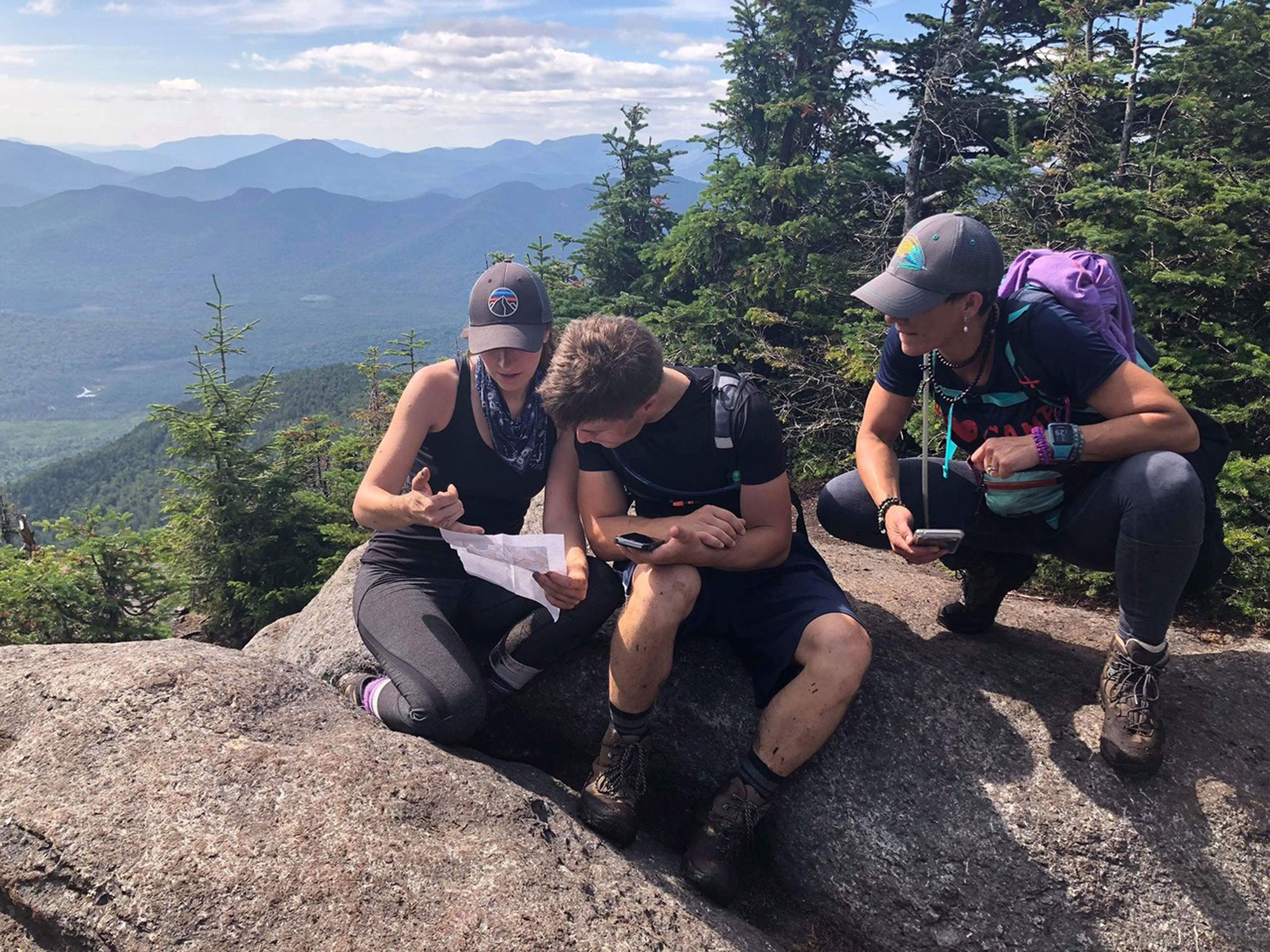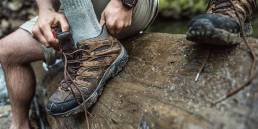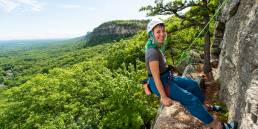On August 19th at 9:30 a.m., I entered the Dix Range, solo, for an intended 18-mile traverse over its five High Peaks. I was running late. Many attempt the loop hike as a day trip, albeit a long one, so I had intended to start hours earlier than I actually did. Rather than change my plans, I would just have to hike faster. Simple.
My gear consisted of three liters of water in a CamelBak, three apples, two Clif bars, two lighters in a Ziploc bag, a Swiss army penknife on my keys, a great pair of Scarpa boots, and an athletic T-shirt and shorts. En route to the trailhead, I texted my father the GPS coordinates and told him that if he hasn’t heard back from me by 9:00 p.m., I have died and he should search for me there. It was a bad joke that would only get worse.
At this point, I had hiked primarily along the Appalachian Trail’s fully blazed trails, and climbed a half-dozen High Peaks before, all with clearly marked, easy-to-follow paths. I knew that some were marked less clearly, but I didn’t realize this route would be notoriously difficult to follow. The maps I had downloaded from AllTrails made it look like any other trail. At the same time, the GPS coordinates I was using as my starting point weren’t for the main trailhead, either.
Instead, I set out from the Route 73 entrance on an unmaintained herd path. However, High Peaks guidebooks dropped this route decades prior. Cairns placed across the river, sometimes hundreds of feet away and with no clear path of boulders to leapfrog across, indicated river crossings. At junctions, a large broken branch indicated the turn. For someone who frequently gets lost in his own hometown, this was like hiking blindfolded.
I lost a good hour and a half following this vague route and killed a large chunk of my phone’s battery while trying to follow the GPS track before I even touched a summit. Feeling the lost time, I started jogging.
After reconnecting with the Bouquet Forks Trail, I quickly summited Grace and South Dix. I arrived on the summit of my third peak—Macomb—at just shy of 4 p.m. At the summit, I met a quartet of women who were finishing their final peak. They graciously offered their map to cross-reference against my dying phone to figure out my route. The leader recognized the gravity of my situation: “Even if you ran the whole way, you couldn’t finish this five-peak loop before sunset.”
Then, my phone died in my hand. I put it back in my pocket, without saying a word.

Racing the Light
The quartet had entered the Dix Range from the Elk Lake Trailhead. At 4 p.m., they had just finished all five of their peaks, doing the loop clockwise and ending on Macomb. In retrospect, I should have abandoned my plan here and exited the wilderness with the group. That would have entailed descending the Macomb Slide with them to their car and bumming a ride back to my VW Beetle at the Route 73 entrance.
That is not what happened. I fully understood it was now impossible to complete the full loop with the dwindling daylight, but I felt I could haul at a clip and retrace my steps back to my car without relying on joining the group of women. I even congratulated myself for the compromise, believing abandoning my plan signaled maturity. Without realizing, I had simply downgraded from the impossible to the extremely difficult, sidestepping a surefire successful exit.
Giving up on completing all five peaks, I started running back down Macomb, retracing my steps over the three peaks I had summited earlier. After returning to Grace, I knew I had minimal light left, but knowing I was off the peaks and in the last several miles back to my car buoyed me forward.
But, the switchbacks on the river, already difficult to follow at a walk, were impossible at a jog. Ducking over and under boulders and waterfalls and navigating a route marked only by cairns, I lost my path, and doubled back. Was that pile of rocks a cairn? Was that branch intentionally broken to indicate direction? I found other herd paths that were not mine. I realized I was losing light fast, and was no longer sure I was even on the right river. Holding my hand to the sun, I had just fingers left of light before the horizon.
Running through my inventory, I realized I had almost no equipment at all: no jacket, tent, blanket, iodine tablets, or anything. My focus shifted immediately from getting out of the woods to surviving them. I decided I needed to get a fire going to keep warm when the temperatures would likely drop into the mid-40s.
There was no time for panic. I found a large downed birch near the bank of the river. It was perpendicular to its course and high enough off the ground to break the wind—perfect for me to lay back against. Then, I scrambled together firewood, until the last ray of light disappeared, and built a small fire in front of my improvised windbreak shelter. From 8 p.m. to 6 a.m., I fed the fire continuously, occasionally awakened by the cold whenever the fire began to ebb. I reached into the dark for my wood pile, fed, and adjusted the fire, before settling again into sleep.
The stars were infinitely clear. Any rustling heard throughout the night never felt threatening. I was never particularly uncomfortable. Though I never forgot the gravity of my situation, the solemnity and clarity of my home for the night filled me with a peace and awe that I have never experienced so intensely before. Though I had little with me, I had just enough for the night.

Searching for a Way Out
When I awakened again at dawn, the embers were down to nearly nothing. And, there was nothing left in my pile of dry wood.
So, I resolved to bushwhack to find my herd path and get out of the woods on my own steam. I began walking up and down one side of the river, spending several hours being torn apart by shrubs and overgrowth. I found dozens of other herd paths, following many of them until their ultimate conclusion: nowhere.
Sometime in the late morning, I realized it would be impossible for me to locate the path without more information, and that I was helplessly lost. While searching, I was wasting energy on a task I realized was fruitless. I cursed my lack of a map. I sat down and took stock.
Panic crept into my mind for a minute or two as I steadied myself on a rock. The sky above started to take the bruised color of filling clouds. Searching any longer for the path would be useless, but I needed to get out of the woods before I had to reckon with a storm.
In the early afternoon, I decided to stay put, hoping for rescue. In the river, a large sandbar mostly made of pebbles stood, flanked by a beaver dam on the downward side. I started making a signal fire from the driftwood. Remembering that birch bark burns oily and black, I leapt from the sandbar and scrambled up a mud wall. In those dozens of trips for birch bark, I cut long strips off a blowdown birch with my minuscule penknife.
I had less than a liter of water by this point, so I couldn’t risk lengthy sun exposure. Instead, if I heard rotors or saw a chopper, I would leap out from the shade to throw more birch onto the fire and would hope they saw the smoke in time.
For about three hours, I hoofed birch bark to the sandbar whenever I heard rotors up close, and threw pounds and armfuls onto the fire, trip after trip. Two or three times, I actually saw a chopper cresting the ridge. Eventually, I realized I needed to wrap my psyche around the idea that I might not be found for days, and thus would need to ration water for an unknown length of time. The deepening bruise in the sky also made me think the coming night would be a wet one. I couldn’t survive an unprotected windy night in the rain at sub-50 degrees, and had to make a lean-to.
By late afternoon, I was far from starving. However, in an effort to prepare myself for being stuck in the woods for an indeterminate length of time, I decided to find something to eat. If it came to killing an animal, I wanted to cross that line earlier rather than later. Although the frog lurking at the river’s muddy bank was too fast for me, I noticed many orange salamanders with black spots (later identified as Eastern red-spotted newts). I am aware that slow-moving, brightly colored animals are commonly toxic. However, in this case, I figured eating a few would be an okay way to test this rule.
I found two, said “I’m so sorry” aloud as I speared them with a stick, and cooked them over the signal fire. Because they were so unbelievably terrible, I presumed they were low-level toxic (I was right). Then, I attempted to figure out how to construct a lean-to.

A Cloud of Fire
As I schemed how I would build a shelter and what I would use, I heard the sound of a chopper quickly getting closer and closer. Heart pounding, I ran back out to the sandbar, waving my hands and screaming, “HELLO! HELP!” At the very moment the chopper crested the ridge, a voice 30 feet to my left exclaimed, “Philip Morris?”
“Is that a human? Yes! It’s me!”
“Are you injured?”
“No. What’s your name?”
“Pat.”
Out of the shrubs appeared a tall, clean-faced young man—younger than me. He had been in the woods for some time.
10 seconds prior, I was alone, having not seen another human for 24 hours. Now it was me and Pat, on a sandbar. An enormous DEC helicopter kicked up dust and leaves in a cyclone over the water.
Pat leapt over the river to the sandbar and radioed to the chopper, now directly overhead. I had intentionally chosen a sandbar large enough for a chopper to land, but hadn’t anticipated the downdraft over the fire and the embers shooting into the sky. For a moment, it felt like a war rescue operation. Pat and I jumped back to pour countless Nalgenes of stream water onto fire. The chopper came down as a maelstrom of sticks, leaves, and dirt swirled around us.
They strapped me into one of the four seats. Just like that, it was over. The chopper was unbelievably loud, and no one spoke. During the entire flight back to Keene, I didn’t spot a single sign of human habitation in any direction. I had ended up taking a tributary off the main river. My car, meanwhile, still sat several miles away, along another branch. Waves of green rolled in every direction as far as the eye could see.

True Professionals
After my parents hugged me, the entire DEC team took turns giving me bear-hugs. My mother, of course, had already promised them that if they found me, I would perform piano pro bono at a DEC event. While I was sure the DEC would ream me out for my lack of knowledge, they were simply glad I came out unscathed.
The DEC team’s professionalism in the High Peaks cannot be overstated. From interviews with my parents, they had built a whole personality profile for me, had dispatched a chopper, and had teams on foot canvassing the area. The officer my parents had spoken to at midnight the prior night stayed on his shift and didn’t leave his post until I was found.
The world is a playground, yes, but comparatively requires a lot more respect and preparation. I have no illusions that a series of thoughtless, compounding errors built on cavalier overconfidence resulted in a huge mobilization of people, grey-hair inducing worry for my family, and a real risk to my life.
I hope that sharing this story makes similarly overconfident folks pause to prepare, and to recognize the humble station that humans occupy in the wilderness. I’ve resolved to never rely on my phone for a map. And, to prepare for only the most ideal outcome, I’ll no longer bring the absolute minimum of gear. To take off into the High Peaks at any point, whether you’re anticipating an overnight or not, it is essential to bring a print map, a good compass, multiple layers (even in summer), iodine tablets, a good knife, and more food than the bare minimum, and to arm myself each and every time with prior research. Physical capacity and good survival instincts are no substitute for preparation.
I survived the night and had a DEC Park Ranger find me. They choppered me out of the High Peaks from a fiery sandbar in the middle of a whitewater stream, framed by one of the Adirondacks’ most remote mountain ranges. While this enduring image humbles me, I’m still thankful for it. The knowledge I gained has put that much more of the wild world within reach.

Lecco Morris
Lecco is a jazz pianist, actor, and poet with a passion for hiking and world travel. He intends to summit the Adirondack’s 46 High Peaks and Colorado’s 14ers, through-hike the Appalachian and Pacific-Crest Trails, walk the Camino del Santiago, and bike the length of the Italian and French coast, to name a few—all while making art, connecting with locals and travelers alike, and learning how best to be alive.
Related Posts
April 24, 2024
What to Bring When Road Tripping with Your Dog
Prepare for the ultimate road trip with…




